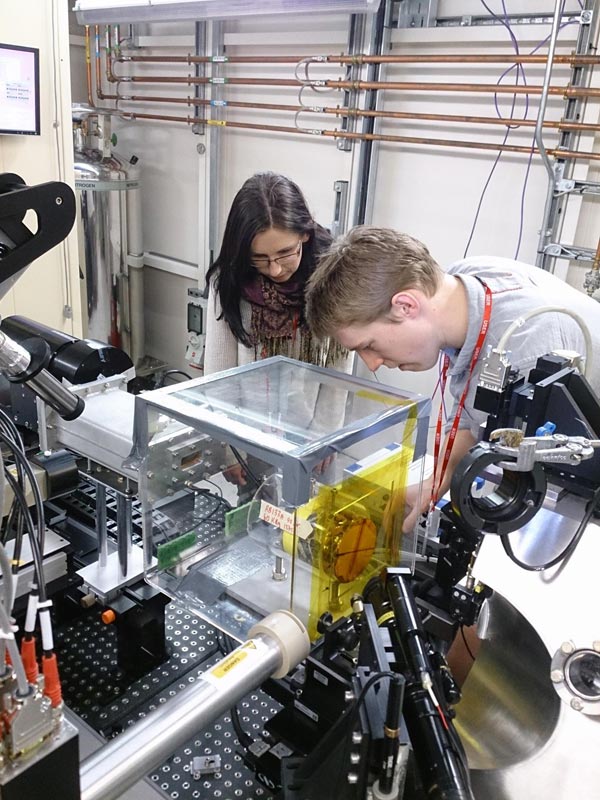Breakthrough offers greater understanding of safe radioactive waste disposal

Safely decommissioning the legacy of radioactively contaminated facilities from nuclear energy and weapons production is one of the greatest challenges of the 21st Century. Current estimates suggest clean-up of the UK's nuclear legacy will cost around £117bn and take decades to complete. Credit: The University of Manchester
Safely decommissioning the legacy of radioactively contaminated facilities from nuclear energy and weapons production is one of the greatest challenges of the 21st Century. Current estimates suggest clean-up of the UK's nuclear legacy will cost around £117bn and take decades to complete.
The team identified a concrete core taken from the structure of a nuclear fuel cooling pond contaminated with radioactive isotopes of caesium and strontium, located at the former Hunterston A, Magnox nuclear power station in Ayrshire. The core, which was coated and painted, was taken to the Diamond synchrotron for further analysis.
Strontium is a high yield nuclear fission product in nuclear reactors and tests showed that it was bonded to the titanium oxide found in the white pigment of the paint on the concrete core's coating.
By identifying the specific location of the radioactive isotopes, the research makes future investigation easier and could potentially leads to more efficient decontamination, saving millions of pounds by reducing the volume of our radioactive waste.
The work also found that the painted and rubberised under layers were intact and the paint had acted as a sealant for 60 years. However, experiments were conducted to examine what would happen if the contaminated pond water had breached the coating. It showed that the strontium would be bound strongly to the materials in the cement but the caesium was absorbed by clays and iron oxides forming part of the rock fragments in the concrete.
Professor Richard Pattrick, leading the project from The University of Manchester's Dalton Nuclear Institute stated: “This work shows the power of the techniques available at the Diamond synchrotron to meet the challenge of cleaning up our nuclear legacy and the University is working very closely with Diamond to develop facilities to support research across the whole of the nuclear industry”
Professor Anthony Banford, Chief Technologist for Waste Management and Decommissioning at NNL, commented: “This research project has demonstrated that collaboration with academia, industry and Diamond scientists, utilising the national scientific infrastructure delivers high quality research with industrial relevance and impact.”
Professor Andrew Harrison, CEO of Diamond Light Source said: “Diamond is very pleased to have facilitated this decommissioning-related research and one major component of our future development plans is to help the UK address the complex and varied challenges of the nuclear industry.”
###
The work is published in the Journal of Hazardous Materials – Citation: W R Bower, K Morris, J F W Mosselmans, O RThompson, A W Banford, K Law, R A D Pattrick. 2016. Characterising legacy spent nuclear fuel pond materials using microfocus X-ray absorption spectroscopy. Journal of Hazardous Materials, 317, 97-107 http://dx.
Media Contact
All latest news from the category: Physics and Astronomy
This area deals with the fundamental laws and building blocks of nature and how they interact, the properties and the behavior of matter, and research into space and time and their structures.
innovations-report provides in-depth reports and articles on subjects such as astrophysics, laser technologies, nuclear, quantum, particle and solid-state physics, nanotechnologies, planetary research and findings (Mars, Venus) and developments related to the Hubble Telescope.
Newest articles

Webb captures top of iconic horsehead nebula in unprecedented detail
NASA’s James Webb Space Telescope has captured the sharpest infrared images to date of a zoomed-in portion of one of the most distinctive objects in our skies, the Horsehead Nebula….

Cost-effective, high-capacity, and cyclable lithium-ion battery cathodes
Charge-recharge cycling of lithium-superrich iron oxide, a cost-effective and high-capacity cathode for new-generation lithium-ion batteries, can be greatly improved by doping with readily available mineral elements. The energy capacity and…

Novel genetic plant regeneration approach
…without the application of phytohormones. Researchers develop a novel plant regeneration approach by modulating the expression of genes that control plant cell differentiation. For ages now, plants have been the…





















